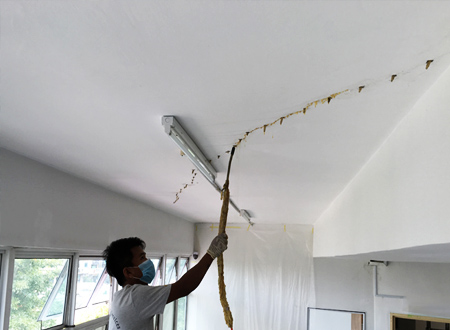A grout is any viscous, packable material that can be used to fill the space between two elements for bonding them or to create a water-tight seal. It is generally a mixture of water, cement, and sand and is employed in pressure grouting, embedding rebar in masonry walls, connecting sections of precast concrete, filling voids, and sealing joints such as those between tiles. Grout is a dense fluid that is used to fill gaps or used as reinforcement in existing structures. Grouts are used in a variety of applications such as repair of cracks, water–stopping in submerged structures such as canals, tunnels, etc., filling seams between tiles, and stabilizing soil. Here we have briefed about the types of grouts used in the repair of cracks. Grout is distinguished by its low viscosity and lack of lime, additionally, grout is thin so it flows readily into gaps. Grout varieties include tiling grout, flooring grout, resin grout, non-shrink grout, structural grout, and thixotropic grout.
There are many different types of grout and they each serve a purpose, which is analyzed below under divisions and sub-divisions.
Cementitious grouts
Cementitious grout is used to create a solid bearing surface between structural baseplates and base foundations. It enables even dispersal of the load into the existing concrete slab. The grout will assist in transferring the overall load of the column into the concrete foundation. Cementitious grout is suitable for a range of different bedding and fixing applications. These include bases, bearing plates, and steel frames. Cementitious is further divided into Sanded, Unsanded grout and Latex modified grout.
Sanded grout
Sanded grout is most commonly used for ceramic tile, stone, and any tile with a grout joint or larger. It is composed of Portland cement, sand, and other additives, it is mixed with water and troweled into the grout joint, where it takes approximately 24 hours to dry. Sanded cementitious grouts include fairly large sand particles that can be seen and felt-they look and feel gritty. Sanded grout is normally recommended when the grout seams are 1/8 inch wide or more, as the sand provides extra bonding power that prevents cracking.
Unsanded grout
Unsanded grout, commonly called “wall grout,” is essentially sanded grout without the sand. It is used on ceramic tile and polished marble with grout joints smaller than 1/8 in. All the cleaning problems associated with sanded grout apply to wall grout, which should be sealed after installation to reduce absorbency. Unsanded grouts have a much smoother texture since the mineral particles they contain are very fine powders that have no noticeable grit. They are used with grout seams that are 1/16 to 1/8 inch wide.
Latex modified grout
Sanded grouts may be formulated with a latex polymer additive, either included in the dry mix or added in as the grout is mixed with water. These additives are blends of acrylics and latex and will decrease water absorption, increase strength and improve color retention. Some grouts have dried latex powder added to them at the factory and do not require additional additives.
Chemical grouts
Chemical grouts are an emulsion of water and liquid resin. Chemical grouting requires the injection of specially formulated chemical grouts into finer cracks that cannot be possible by cement grouts. Some of the popular ones are epoxy, acrylic, and furan resin grouts.
Epoxy grout
Epoxy grout is strong and durable. It is highly resistant to stains, cracks, chemicals, harsh weather conditions, and climate changes. These characteristics make epoxy grout the only way to go if you’re looking for the most durable, efficient way to do tile work. The strength of epoxy grout makes it perfect for any tile job, indoors or outdoors. The stain, crack and chemical-resistant properties make it suitable for areas with high traffic. The resistance to weather and climate changes make it ideal for areas where it will be subjected to harsh weather conditions or excessive amounts of humidity or severe cold. Epoxy grouts also tend to be less fluid than cementitious grouts and this can have a bearing on the choice for your project. If you are grouting under large equipment or base plates it may be easier to use a free-flowing cementitious grout.
Epoxy grout will not crumble and begin to fall apart over time, whereas traditional grout products tend to weaken, making it more likely you will incur the expense of redoing your tile at some point if you use cement-based products. With light maintenance, Epoxy grout will last a lifetime, so you know you’re never going to have to invest in extensive and expensive tile replacement.
Acrylic grout
With acrylic grout is that you don’t have to cover the entire work surface. You can just apply it to the joints between the tiles. The silicone additive, which comes premixed with Portland cement grout, aid s in greater adhesion. Because of its stability in freezes and thaws, it can be used outdoors, making it perfect for deck or garage projects. The additive helps the grout retain color and resist stains. It’s the kind of grout that most fast-food restaurants use on their floors. Some companies specialize in creating acrylic caulks to match a tile or paint colors.
Furan grout
Furan grout is similar to epoxies, but is composed of polymers of furfuryl alcohol, which are highly resistant to chemical action. Furans are two-component systems that contain a furan resin and a filler powder with an acid catalyst. It is the acid catalyst that causes the furan resins to cure, forming a thermosetting resin that has an unsurpassed chemical, physical and thermal resistance.
Furan grout is commonly used to grout brick pavers and quarry tile and it is also recommended in areas exposed to chemicals and grease. The tile surfaces may be smooth, non-skid, or abrasive, depending on the intended use for the floor. The tile or brick surfaces must receive a wax coating to protect them from staining before the installation of furan.
Polyester grouts
For decades, grouting has been the most popular soil stabilization method. Some additives, as well as cement and polymeric materials, are also widely used as grout mixtures to lower costs and achieve the best engineering properties with early strength gain. Unconfined compression and dynamic tests of grouted granular soils were conducted with different mixtures to evaluate the feasibility of using polyester, red mud, and micronized clay as grouting materials. This type of grouts advances with increasing additive percentages and curing time. Polyester grout is used for anchoring to impart strength to foundations that must be achieved in limited available space.
Non-shrink grout
Non-shrink grouts are hydraulic cement grout that, when hardened under stipulated test conditions, do not shrink, so its final volume is greater than or equal to the originally installed volume. It is often used as a transfer medium between load-bearing members. This grout often sets rapidly. It is a pre-mix product that needs only to be mixed with [water] which includes ingredients to compensate against cement stone shrinkage.
Conclusion
Grouting aids to utilize a mix of cement and sand along with other materials to fill the spaces that may result during some construction operation. The selection of grout types is pivotal. Whether you are searching for floor tile or paver, it is an important component so always take the opinion of an expert. Each project requires a different type of grout, so choose wisely.

